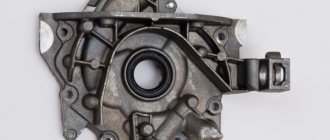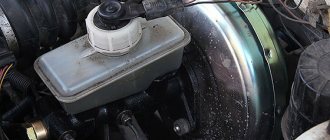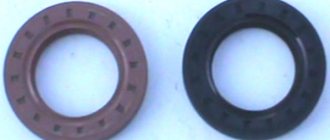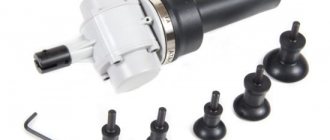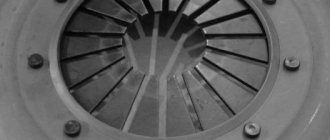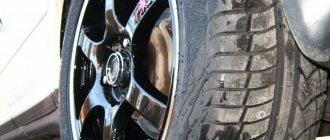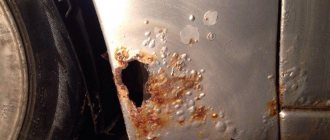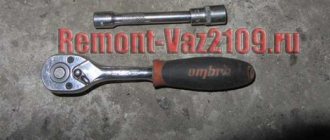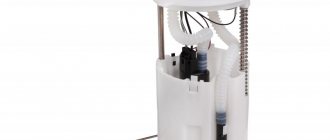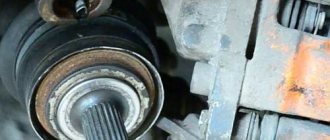Removing the oil pump
To remove the oil pump, we prepare the car.
We install it on a viewing hole or a lift. Remove the negative terminal of the battery.
Drain the oil from the engine.
Remove the generator belt.
Unscrew the three bolts and remove the front camshaft drive cover.
Install the piston of the upper cylinder at the top cylinder.
To do this, turn the crankshaft by the pulley mounting bolt so that the mark on the camshaft pulley is opposite the mark on the rear cover of the camshaft drive.
Remove the generator drive belt and unscrew the crankshaft pulley bolt, securing the shaft from turning with a screwdriver.
Remove the pulley from the crankshaft.
Loosen the tension roller nut.
Rotate the roller, thereby releasing the belt tension.
After removing the camshaft drive belt, do not turn the camshaft and crankshafts, as this may cause the pistons to hit the valves.
Remove the timing pulley from the crankshaft.
Unscrew the three bolts securing the lower protective cover of the clutch housing and remove it.
Unscrew the sixteen bolts securing the oil sump and remove it.
Remove the oil pan seal.
Remove the two bolts securing the oil pickup to the main bearing cap.
Unscrew the bolt securing the oil receiver to the oil pump and remove the oil receiver
Remove the six oil pump mounting bolts
Use a screwdriver to move the oil pump by inserting it between the pump and the main bearing cap.
Remove the oil pump from the crankshaft
Reasons for the indicator light and diagnostic methods
A sufficiently experienced car owner can independently diagnose or repair this system. Otherwise, it is recommended to contact a service center for help.
Sensor malfunction
To check the serviceability of the sensor, it is necessary to perform a number of operations:
- Turn the ignition key to the first position (turn on the ignition).
- Make sure the pressure indicator lights up.
- Open the engine compartment and disconnect the sensor wire.
- Make sure the indicator is not lit.
- Attach the bare end of the wire to ground, for example to the engine housing.
- The indicator on the dashboard should light up. If so, the wire is OK and the cause of the malfunction lies in the sensor.
The manufacturer does not recommend disassembling or repairing the sensor. It needs to be replaced.
Violation of the integrity of electrical wiring
Due to large temperature changes, ingress of fuels and lubricants, natural drying or mechanical damage in the engine compartment, electrical wiring is a vulnerable part of the vehicle's electrical systems.
Checking its integrity can be visual, by inspecting visible parts, or using a multimeter to check the conductivity and resistance of the wire.
This check is carried out strictly in accordance with the electrical diagram of the VAZ 2109 car.
Low engine oil level
During the operation of the vehicle, minor consumption of engine oil is allowed. Checking its level should be done using a special dipstick with the engine cold or not running for more than 10 minutes.
It is necessary to check its level using the dipstick and, if necessary, top up. The indicator is then rechecked with the engine running.
Low oil levels can also be caused by oil leaks.
Engine wear
Engine operation involves constantly rubbing metal surfaces. No matter how well they are lubricated, wear is inevitable.
In internal combustion engine elements such as the piston group and the timing mechanism (gas distribution mechanism), there are special oil channels. Through them, the most inaccessible rubbing surfaces are lubricated. Due to prolonged use of the vehicle and engine wear, the sealing of the channels is lost and the oil pressure drops. To eliminate this problem, you need to completely disassemble the internal combustion engine and overhaul it.
Pump fault
The oil pump is a device located at the bottom of the engine crankcase that is driven by a mechanical connection to the crankshaft gear. Due to its rotation, oil pressure is generated. The higher the engine speed, the higher the pressure level. Lack of maintenance and untimely replacement of technical fluids, as well as a long service life, can affect the quality of the pump.
To check it, a pressure gauge is used, which is screwed into the technical hole of the sensor.
When the engine is running at idle speed, the pressure should be ±1.5 atmospheres (kg/cm2), and when the speed increases - up to 5–6 atmospheres.
Engine
Installation of a 16 valve engine on a VAZ 2109 can be done in 2 ways. Each has its own pros and cons. Therefore, you can choose one of these methods:
- Installation of the whole unit;
- Replacing the cylinder head.
The final choice depends on your goals and capabilities. If you have a complete and serviceable engine, you can install it. Otherwise, when buying parts from scratch, it is better to install a new head.
To remake your "nine" it is best to use a motor from a VAZ 2112
. They are almost identical. The differences are only in small details. But these nuances are precisely what make this engine more modern. What is important for you is that this engine fits perfectly into the mounts. In this case, you can even use the original box and clutch basket. Next, we will analyze these methods in more detail.
Replacing the oil pump on VAZ 2108, VAZ 2109, VAZ 21099
Welcome! 1. Have you ever had this happen? You are driving your car and suddenly the warning light comes on, indicating that the oil pressure in the system is low. Many people first go to fill the engine with oil, but after filling they sit behind the wheel and see that the light has not stopped burning, what is the reason?
2. In fact, there can be a lot of reasons here, starting from the oil pressure sensor, which may fail and therefore the oil pressure lamp will light, and ending with the oil pump itself, which may simply be faulty or the parts located in it may work incorrectly. Incorrect operation of parts is treated by repairing the oil pump itself. (How to repair an oil pump, see the article: “Oil pump repair”)
Where is the oil pump located? It is located behind the crankshaft pulley, and because of this, you can clearly see the oil pump only when the pulley is removed from the car engine. Just below, look at the photo, which shows the oil pump itself, which is attached to the cylinder block by six bolts securing it.
When should you change the oil pump? If the oil pump malfunctions, the following occurs:
• Firstly, the oil pressure in the system decreases, which is indicated by the oil pressure light.
• And secondly, oil consumption in the system will most likely also increase, which will lead to constant addition of engine oil to the engine.
Fuel system
Fuel tank, Water level sensor, Fuel level sensor, Tank vent valve, Fuel tank button, Fuel tank cap, Fuel neck, Fuel pump, Fuel pump, Fuel pump strainer, Fuel pump gasket, Fuel pump relay, Fuel injector, Injector ring, Throttle valve, Sensor throttle valve, Throttle pipe, Idle air regulator, Air receiver, Throttle valve heating tube, Turbine (turbocharger), Turbine gasket, Solenoid valve, Injection pump, Injection pump valve, Compressor, Compressor gasket, Carburetor, Fuel rail (rail), Fuel pressure regulator , Fuel line, Fuel valve, Fuel hose, Fuel pipe, Air flow meter, Engine control unit, Air pipe, Intake manifold, Intake manifold gasket, Additional air pump, Fuel pump, Gas pedal, Potentiometer, Throttle cable
Causes of malfunction of VAZ 2108/2109 oil pumps
Before deciding to repair or replace the oil pump, it is worth understanding the reasons that may indicate problems. By the way, problems are possible not only with the mechanism itself, but also with other elements of the lubrication system:
- decrease in pressure in the crankcase;
- problems with pressure sensors;
- use of low quality motor oil;
- using oil that is not suitable for this vehicle;
- problems with the lubrication or safety valve;
- oil filter clogged;
- contamination of the oil receiver or pump housing.
Contamination of the oil receiver leads to a decrease in pressure in the system and the light comes on.
The blockage may occur due to contamination of the engine crankcase itself. The problem is solved by removing and cleaning the pan. The operation of the oil pump can be disrupted by other problems that are identified during the diagnostic process. These include:
- gasket damage;
- unreliable filter fastening;
- high wear of mechanism parts;
- reduction valve failure.
The oil pump is a fairly reliable component with a long service life. Breakdowns usually occur due to improper repairs or poor quality lubricants.
